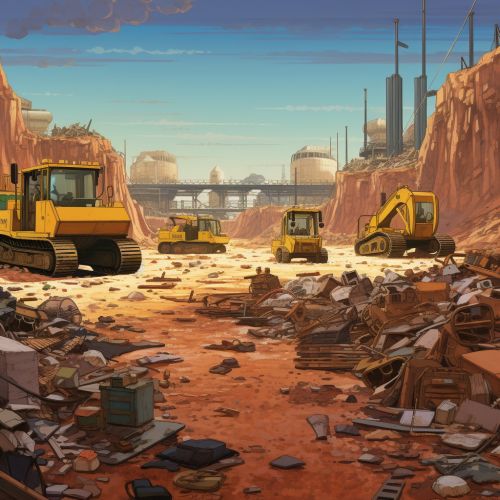Landfills
Overview
Landfills are engineered ground facilities designed for the disposal of waste materials. They are among the most common methods of organized waste disposal and remain a critical part of waste management systems worldwide.


History
The practice of landfilling can be traced back to ancient times. However, the modern concept of sanitary landfills evolved in the 20th century, with the first sanitary landfill in the United States opening in Fresno, California, in 1937.
Design and Operation
Landfills are more than mere dumps. They are carefully designed and operated facilities. The design process involves a series of steps, including site selection, design, operation, and post-closure care.
Site Selection
The selection of a suitable site for a landfill is a complex process that involves the consideration of several factors such as geology, hydrology, proximity to populated areas, and accessibility.
Design
The design of a landfill involves the creation of a barrier or liner at the bottom of the landfill to prevent the migration of leachate (liquid that has percolated through a solid and leached out some of the constituents) into the underlying soil or groundwater.
Operation
The operation of a landfill involves the deposition of waste in layers, compacting the waste to reduce its volume, and covering the waste with soil or other types of cover material.
Post-Closure Care
Once a landfill reaches its capacity, it is closed and capped with a final cover. The site is then monitored for a period of time to ensure the integrity of the cap and the liner system.
Environmental Impact
Landfills have significant environmental impacts. They can lead to the contamination of groundwater and surface water, the emission of greenhouse gases, and the degradation of local ecosystems.
Groundwater and Surface Water Contamination
One of the primary environmental concerns associated with landfills is the potential for groundwater and surface water contamination due to the migration of leachate.
Greenhouse Gas Emissions
Landfills are a significant source of methane, a potent greenhouse gas. The decomposition of organic waste in landfills produces methane, which can contribute to global warming if not properly managed.
Degradation of Local Ecosystems
The presence of a landfill can have detrimental effects on local ecosystems. The disturbance of land during the construction and operation of a landfill can lead to habitat loss and fragmentation.
Landfill Technologies
There are several technologies associated with the operation and management of landfills. These include leachate collection and treatment systems, gas collection and utilization systems, and landfill cover systems.
Leachate Collection and Treatment Systems
These systems are designed to collect and treat leachate generated within the landfill. The treatment process typically involves biological, chemical, and physical processes to remove contaminants.
Gas Collection and Utilization Systems
These systems are designed to collect landfill gas, primarily methane, for beneficial use. The collected gas can be used to generate electricity, heat, or other forms of energy.
Landfill Cover Systems
These systems are designed to minimize the infiltration of water into the landfill, which can reduce the generation of leachate and the emission of landfill gas.
Future Trends
The future of landfilling is likely to be influenced by several factors, including advances in technology, changes in waste management practices, and evolving regulatory frameworks. There is a growing emphasis on waste reduction, recycling, and recovery, which may reduce the reliance on landfilling.
